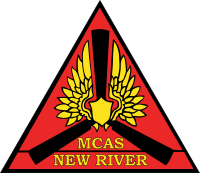Marine Corps Air Station New River
Coordinates: 34°42′26″N 077°26′43″W / 34.70722°N 77.44528°W
| MCAS New River McCutcheon Field | |||||||||||||||
|---|---|---|---|---|---|---|---|---|---|---|---|---|---|---|---|
|
MCAS New River Insignia | |||||||||||||||
| Summary | |||||||||||||||
| Airport type | Military | ||||||||||||||
| Operator | United States Marine Corps | ||||||||||||||
| Location | Jacksonville, North Carolina | ||||||||||||||
| Built | 1943 | ||||||||||||||
| In use | 1943 - present | ||||||||||||||
| Commander | Col. Russell C. Burton[1] | ||||||||||||||
| Occupants |
Marine Aircraft Group 29 Marine Aircraft Group 26 | ||||||||||||||
| Elevation AMSL | 26 ft / 8 m | ||||||||||||||
| Website | www.newriver.marines.mil | ||||||||||||||
| Runways | |||||||||||||||
| |||||||||||||||
Marine Corps Air Station New River (ICAO: KNCA, FAA LID: NCA) is a United States Marine Corps helicopter and tilt-rotor base in Jacksonville, North Carolina, in the eastern part of the state. In 1972, the airfield was named McCutcheon Field for General Keith B. McCutcheon, one of the fathers of Marine Corps helicopter aviation. Near Marine Corps Base Camp Lejeune, it shares some facilities with Camp Geiger.
Resident units
- Headquarters and Headquarters Squadron
- Marine Aircraft Group 26
- Marine Aircraft Group 29
- VMX-22
- Center for Naval Aviation Technical Training
- Marine Wing Support Squadron 272
- Marine Air Control Squadron 2, Det. B
- 362nd Training Squadron, Detachment 1, Operating Location "A" (USAF)
History
The base was originally 29 parcels of land, a simple stretch of tobacco farm that was purchased for $64,502 in 1941. Officials at Camp Lejeune investigated the area in search of an existing airfield for hosting aircraft in support of amphibious operations. Capt. Barnett Robinson, a member of Marine Glider Group 71, concluded in his search that the farmland would suit the Marine Corps’ needs.
The location was placed under the command of Marine Corps Base Camp Lejeune and received its first squadron, VMSB-331 from Marine Corps Air Station Cherry Point on March 9, 1943. On June 1, VMSB-331 was divided in half to create VMSB-332. However, both squadrons were soon after relocated to Bogue Field. From mid-1943 through August 1944, Marine bombing squadrons VMB-433, VMB-443 and VMB-612 operating the land-based PBJ Mitchell bomber were stationed there. On April 26, 1944, the area of land around New River and Peterfield Point, named after the original owner of the farmland that was part of the government purchase, was commissioned Marine Corps Auxiliary Airfield Camp Lejeune. This delineated the airfield from Camp Lejeune, and marks its official birth as a separate Marine Corps installation. Over the next few years, paratrooper Marines, glider troops and air delivery personnel were trained in King Air hangar, the Stations’ first hangar, which was transported from Marine Corps Recruit Depot Parris Island, South Carolina.

As World War II came to an end, MCAAF Camp Lejeune was closed and reverted to caretaker status as an outlying airfield of MCAS Cherry Point. This didn’t last long, however, as in 1951 the installation was reactivated and became Marine Corps Air Facility Peterfield Point, Camp Lejeune. Only one year later the name was changed again, this time to Marine Corps Air Facility New River. July 1954 marked the arrival of the first operational Marine Aircraft Group, MAG-26, which was transferred from MCAS Cherry Point.
The area faced another major name change in 1968, where it was recommissioned as Marine Corps Air Station (Helicopter) New River, marking its growth from a small training area to a major operational airfield.
In 2015, MCAS New River started hosting Global Rallycross racing series on Independence Day weekend.[4] The race weekend was expanded to two rounds in 2016,[5] but did not return for the 2017 season.[6]
MV-22 Osprey
The Air Station was the first Marine Corps base with the new MV-22 Osprey. It has the ability to fly like a plane, and take off and land like a helicopter. The MV-22 has replaced all of the CH-46E Sea Knights on the east coast with the exception of HMX-1 and HMM-774. Currently there are six operational Osprey squadrons, VMM-261, VMM-263, VMM-162, VMM-365, VMM-264, and VMM-266.
See also
- List of United States Marine Corps installations
- United States Marine Corps Aviation
- List of airports in North Carolina
- Camp Davis
References
- Shettle Jr., M. L. (2001). United States Marine Corps Air Stations of World War II. Bowersville, Georgia: Schaertel Publishing Co. ISBN 0-9643388-2-3.
- "MCAS New River RotoVue", the military-authorized newspaper
Notes
- ↑ "Marine Corps Air Station New River". U.S. Marine Corps. Retrieved 2016-07-13.
- ↑ Marine Corps Air Station New River Archived 2005-05-19 at the Wayback Machine., official site, retrieved 2007-11-12
- ↑ FAA Airport Master Record for NCA (Form 5010 PDF), effective 2007-10-25
- ↑ Jordan, Dave; Cardin, Rachael (July 3, 2016). "MCAS New River hosts Red Bull Global Rallycross". WITN-TV. Retrieved December 8, 2016.
- ↑ "GRC race preview: MCAS New River". Motorsport.com. July 1, 2016. Retrieved December 8, 2016.
- ↑ Wilde, Dominik (February 2, 2017). "Red Bull GRC announce 2017 schedule". The Checkered Flag. Retrieved August 9, 2017.
External links
- USMC Air Station New River Overview & PCS Information (MarineCorpsUSA.org)
- FAA Airport Diagram (PDF), effective July 20, 2017
- Resources for this U.S. military airport:
- FAA airport information for NCA
- AirNav airport information for KNCA
- NOAA/NWS latest weather observations
- SkyVector aeronautical chart for KNCA


